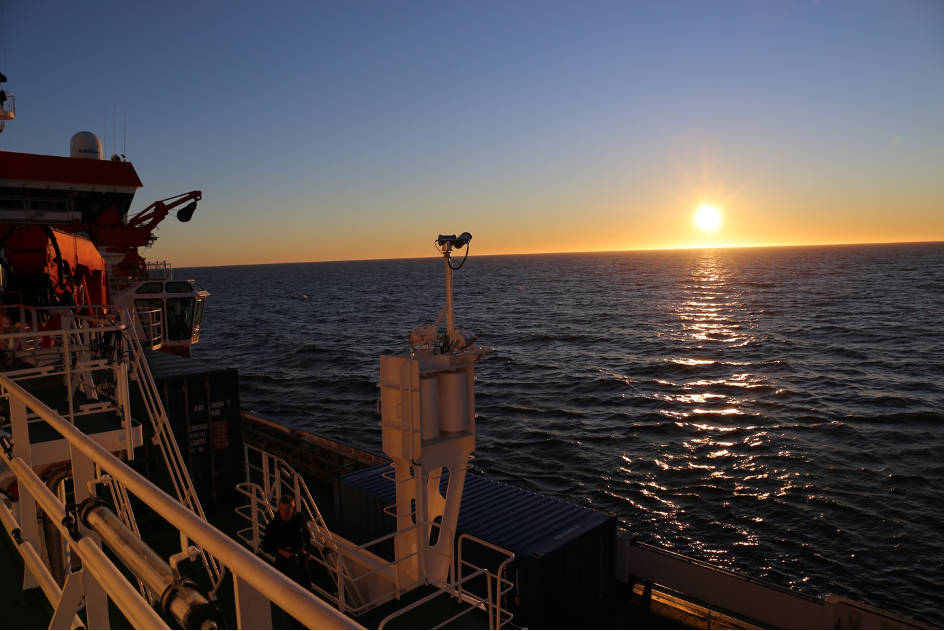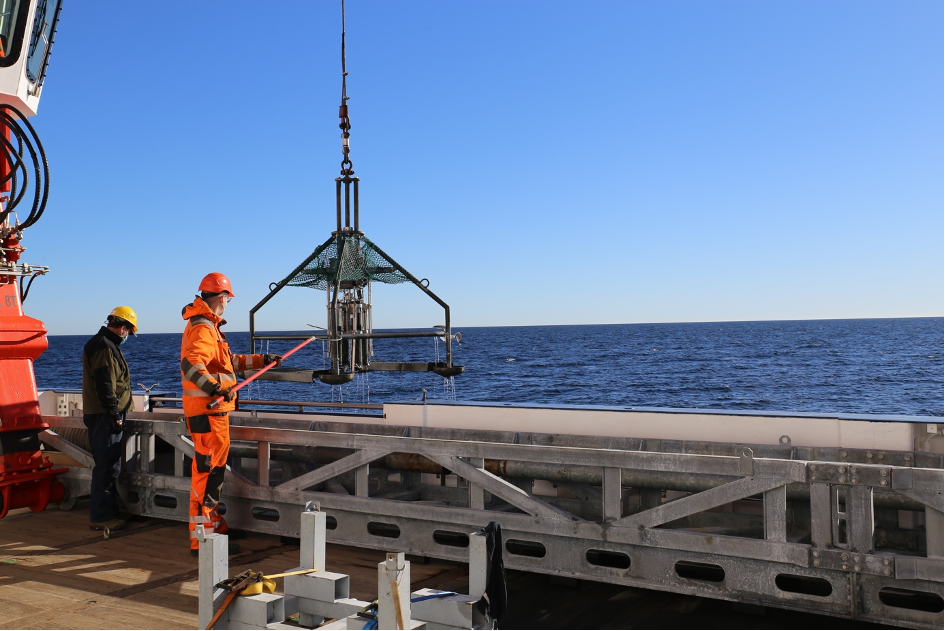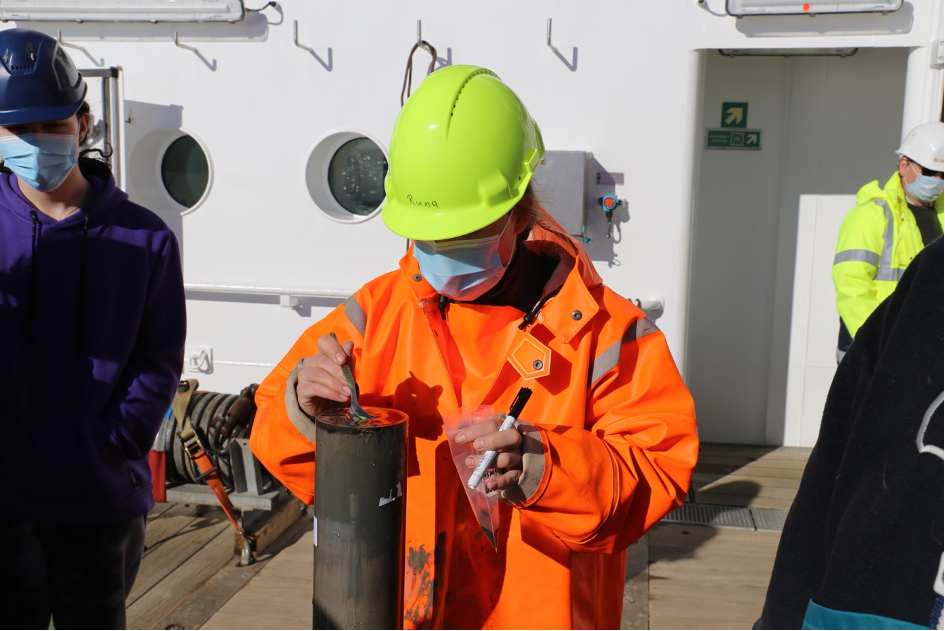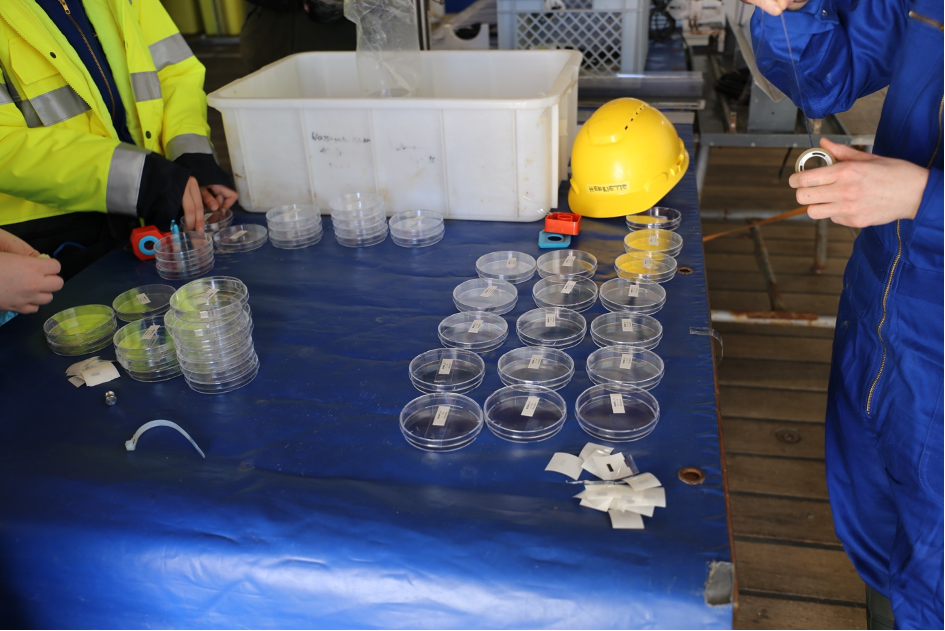Wir sind auf dem Weg ins Bornholm-Becken, das nächste tiefe Becken östlich der Darsser Schwelle. Befährt man die Ostsee von West nach Ost, schliesslich nach Nordost, so schließen sich hinter der Darsser Schwelle immer tiefere Becken an. Nach dem Arkona Becken mit rund 50 m Tiefe ist das Bornholm Becken, östlich der Insel Bornholm, mit rund 80 m schon deutlich tiefer.
We are on our way to the Bornholm Basin, the next deep basin east of the Darss Sill. If you sail the Baltic Sea from west to east, finally to northeast, deeper and deeper basins join behind the Darss Sill. After the Arkona Basin with about 50 m depth, the Bornholm Basin, east of the island of Bornholm, is already considerably deeper with about 80 m.

Für heute sind viele MUC-Einsätze geplant. MUC steht für Multicorer – also ein Gerät, bei dem man bei einem Einsatz gleich mehrere kurze Kerne (engl.: core) ziehen kann. Es wird immer dann eingesetzt, wenn die obersten – jüngsten Ablagerungen untersucht werden sollen.
Many MUC operations are planned for today. MUC stands for multicorer – a device that can pull several short cores in one deployment. It is always used when the uppermost – the youngest – deposits are to be examined.

Svenja Papenmeier und Anina Hinz, die im wissenschaftlichen Team für die Sedimentakustik zuständig sind, haben die Nacht über sedimentakustische Profile aufgenommen, um eine Stelle zu finden, an der die Ablagerungen über dem Baltischen Eisstausee besonders dünn sind.
Svenja Papenmeier and Anina Hinz, who are responsible for sediment acoustics in the scientific team, spent the night analysing profiles to find a spot where the sediments above the Baltic Ice Lake are particularly thin.
Die Sedimente des Baltischen Eisstausees sind die ersten Ablagerungen nach dem Zerfall des Eisschildes der letzten Eiszeit und wurden vor rund 10.000 Jahren abgelagert. Sie werden uns auf unserer Fahrt noch weiter begleiten. Charakteristisch ist ihr hoher Ton- und geringer Organik-Anteil. Sie sind beige-rosa gefärbt und zeigen meist die für einen Eisstausee typischen Warven – eine jahreszeitliche Schichtung.
The sediments of the Baltic Ice Lake are the first deposits after the disintegration of the ice sheet of the last ice age and were deposited about 10,000 years ago. They will continue to accompany us on our journey. Characteristic is their high clay and low organic content. They are beige-pink in colour and usually show warves typical of an ice lake – a seasonal stratification.
Der Sedimentstapel, der auf diesen Tonen liegt, repräsentiert die nacheiszeitliche Geschichte der Ostsee. Man weiss heute sehr gut, wie diese Abfolge idealerweise aussieht. Dazu demnächst mal mehr. Die große Frage ist, warum lagern hier nur so wenige Sedimente über den Eisstausee-Sedimenten? Offensichtlich wurde der Großteil erodiert, aber wann? Und wohin wurde das Material transportiert? Die Vermutung: winterliche Tiefenwasserbildung führte zu Strömungen, die die Überdeckung der Eisstausee-Sedimente regelmäßig abräumte. Aber es gibt heutzutage keine so tiefreichende winterliche Umwälzung im Bornholmbecken. Wann war das also anders und warum?
The sediment stack lying on these clays represents the post-glacial history of the Baltic Sea. Today we know very well how this sequence ideally looks like. We will report on that later. The big question is, why are there so few sediments overlying the lake sediments here? Obviously, most of it was eroded, but when? And where was the material transported? The assumption: winter deep water formation led to currents that periodically cleared the cover of the ice lake sediments. But there is no such deep winter overturning in the Bornholm Basin today. So when was it different and why?
Die Station, auf der wir den MUC zum Einsatz bringen, ist ideal. Das Material, das wir aus der Tiefe holen, ist weich und sehr dunkel – typisch für die Ablagerungen der letzten Jahrhunderte.
The station where we deploy the MUC is perfect. The material we retrieve from the depths is soft and very dark – typical of the deposits of the last few centuries.

Der Inhalt der Röhren wird Zentimeter für Zentimeter in große Petrischalen überführt und für die spätere Untersuchung in Kiel gesichert. Henriette Kolling koordiniert die Probenahme. Sie interessiert sich besonders für Biomarker in den Sedimenten – also Zeugen in Form von Mikrofossilien oder besonderen Molekülen, die als Hinweis auf ganz bestimmte Umweltbedingungen gelten. So lassen sich Rückschlüsse auf das jeweilige Klimaregime ziehen. In Kombination mit einer Altersdatierung ist dann die Zuordnung zu einer der bekannten nacheiszeitlichen Klimaperioden – wie die “Mittelalterliche Wärmeperiode” oder die “Kleine Eiszeit”. Diese information hätten an Bord gerne alle sofort! Aber analysiert wird erst zuhause. Hauptsache, die Proben sind gewonnen und gesichert!
The contents of the tubes are transferred centimetre by centimetre into large Petri dishes and secured for later examination in Kiel. Henriette Kolling coordinates the sampling. She is particularly interested in biomarkers in the sediments – witnesses in the form of microfossils or special molecules that are considered to indicate very specific environmental conditions. In this way, conclusions can be drawn about the respective climatic regime. In combination with an age dating, it is then possible to assign them to one of the known post-glacial climate periods – such as the “Medieval Warm Period” or the “Little Ice Age”. Everyone on board would like to have this information immediately! But the analysis is done at home. The most important thing is that the samples have been obtained and secured!

Text and photos by Barbara Hentzsch (IOW)